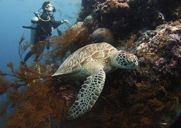Marine Plastic Kills Seabirds
Sea birds which forage in the Tasman Sea are eating plastic, thinking it is food and are dying in large numbers on Lord Howe Island. Large amounts of plastic are found in the stomachs of shearwaters and one survey found more than 200 pieces in one bird alone and up to 50 in others. The plastics have very sharp edges and tear their internal organs. Toxic substances bind to this plastic, and mercury, toxic to birds at 4 parts per million, was found to be as high as 30,000ppm. 95% of nesting shearwaters on Lord Howe Island were found to have plastic in their stomachs.
It was thought that the huge N Pacific garbage patch or gyre north of Hawaii, which gathers plastics from N America and Asia, was the source of their problem but the migratory birds had none in their stomachs when they arrived in September. From Lord Howe, they forage in the Tasman Sea off the coast of NSW, Vic and Tasmania and a few months later are found to be full of plastic.
The shearwater numbers have halved since 1970 on Lord Howe and very few chicks were found this year. Recently, a giant petrel which roams from the Antarctic to the Tasman Sea, died at Lakes Entrance and it was found to have a piece of plastic lodged in its crop and Styrofoam in its stomach. Marine plastics accumulate and concentrate chemicals such as PCBs and the pesticide DDT.
To help save our seabirds why not take a bag to the beach when you go for your walk and pick up any bits of plastic that you see.
Thanks to Andrew Darby whose original article appeared in the Sydney Morning Herald
Turtle dies from 317 Pieces of Plastic
A dead green sea turtle with more than 317 pieces of plastic in its digestive system, was recently found washed up on a Ballina beach. Rochelle Ferris from the Australian Seabird Rescue said it was the most shocking case she had seen in 15 years and there was no doubt that the plastic killed the animal:
It was thought that the huge N Pacific garbage patch or gyre north of Hawaii, which gathers plastics from N America and Asia, was the source of their problem but the migratory birds had none in their stomachs when they arrived in September. From Lord Howe, they forage in the Tasman Sea off the coast of NSW, Vic and Tasmania and a few months later are found to be full of plastic.
The shearwater numbers have halved since 1970 on Lord Howe and very few chicks were found this year. Recently, a giant petrel which roams from the Antarctic to the Tasman Sea, died at Lakes Entrance and it was found to have a piece of plastic lodged in its crop and Styrofoam in its stomach. Marine plastics accumulate and concentrate chemicals such as PCBs and the pesticide DDT.
To help save our seabirds why not take a bag to the beach when you go for your walk and pick up any bits of plastic that you see.
Thanks to Andrew Darby whose original article appeared in the Sydney Morning Herald
Turtle dies from 317 Pieces of Plastic
A dead green sea turtle with more than 317 pieces of plastic in its digestive system, was recently found washed up on a Ballina beach. Rochelle Ferris from the Australian Seabird Rescue said it was the most shocking case she had seen in 15 years and there was no doubt that the plastic killed the animal:
“The governments must take charge of stormwater drainage that goes into our rivers and waterways, which is just feeding a constant stream of this garbage into our marine environment”.



